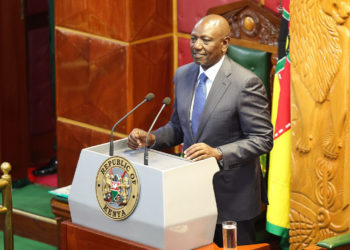Kenya is poised to set a record for the lowest budget deficit in 15 years, signalling a period of fiscal
consolidation driven by judicious expenditure reduction and robust revenue mobilization strategies.
The National Treasury has unveiled a budgetary projection that anticipates a deficit of KES 514.7 billion, which
amounts to 2.9% of the nation’s gross domestic product (GDP).
This forecast, presented to the legislative body this past Tuesday, represents a significant improvement from the previous estimates of 3.9% for the fiscal year ending June 2025.
The Treasury’s fiscal strategy is carefully crafted to balance the dual objectives of mitigating the rise in public
debt and alleviating societal grievances, all while navigating the challenging fiscal limitations that Kenya faces,
further compounded by persistent financing hurdles. Achieving this fiscal target would result in the most
slender budget deficit since the 2% recorded in 2008.
However, according to the Exchequer issues for the ninth month ending 28th March 2024, Kenya Revenue
Authority (KRA) had only managed to collect KES 1.5 trillion in tax revenue, which is 82.0% of the prorated KES
1.9 trillion, and 61.5% of the FY’2023/24 estimates of KES 2.5 trillion, which raises the concerns of whether the
government will achieve the set targets.
The government’s medium-term goal is to elevate revenue to 20.2% of GDP by instituting new tax policies, introducing fees for immigration-related services, and discontinuing ineffective tax incentives.
The Treasury anticipates a 18.8% increase in ordinary revenue, projecting it to reach KES 2.9 trillion, up from a
revised KES 2.5 trillion for the current fiscal year.
Total projected expenditures are expected to experience a slight uptick to KES 3.9 trillion, which includes KES 2.8 trillion allocated for recurrent costs and KES 687.9 billion earmarked for development projects.
In a bid to optimize budgetary allocations, the Treasury has reduced its spending estimates by KES 267.5 billion from the initial figures stated in the Budget Policy Statement (BPS), focusing on the elimination of
expenditures deemed non-essential.
For the upcoming fiscal year, the Treasury intends to cover the budgetary shortfall through a mix of net
external borrowing of KES 256.8 billion and net domestic borrowing of KES 257.9 billion.
Debt servicing commitments are projected to escalate to KES 1.9 trillion, which includes KES 259.9 billion for foreign interest payments and KES 330.7 billion for the repayment of maturing external debt.
This schedule of repayments will commence with the first instalment of the Eurobond debt due in 2027, which is scheduled to be paid in three yearly instalments of USD 300.0 million starting in May 2025.
The Treasury forecasts that the ratio of the present value of debt to GDP will descend below the 55.0% benchmark only by the year 2029, a decrease from the current estimate of 67.2% and the projected 64.0% in 2025.
In an effort to streamline government functions and enhance efficiency, the Treasury has identified 25
state-owned enterprises for privatization. Additionally, 41 entities are slated for amalgamation to eliminate
redundancies, 42 will undergo restructuring, and 25 agencies are set for dissolution.


















